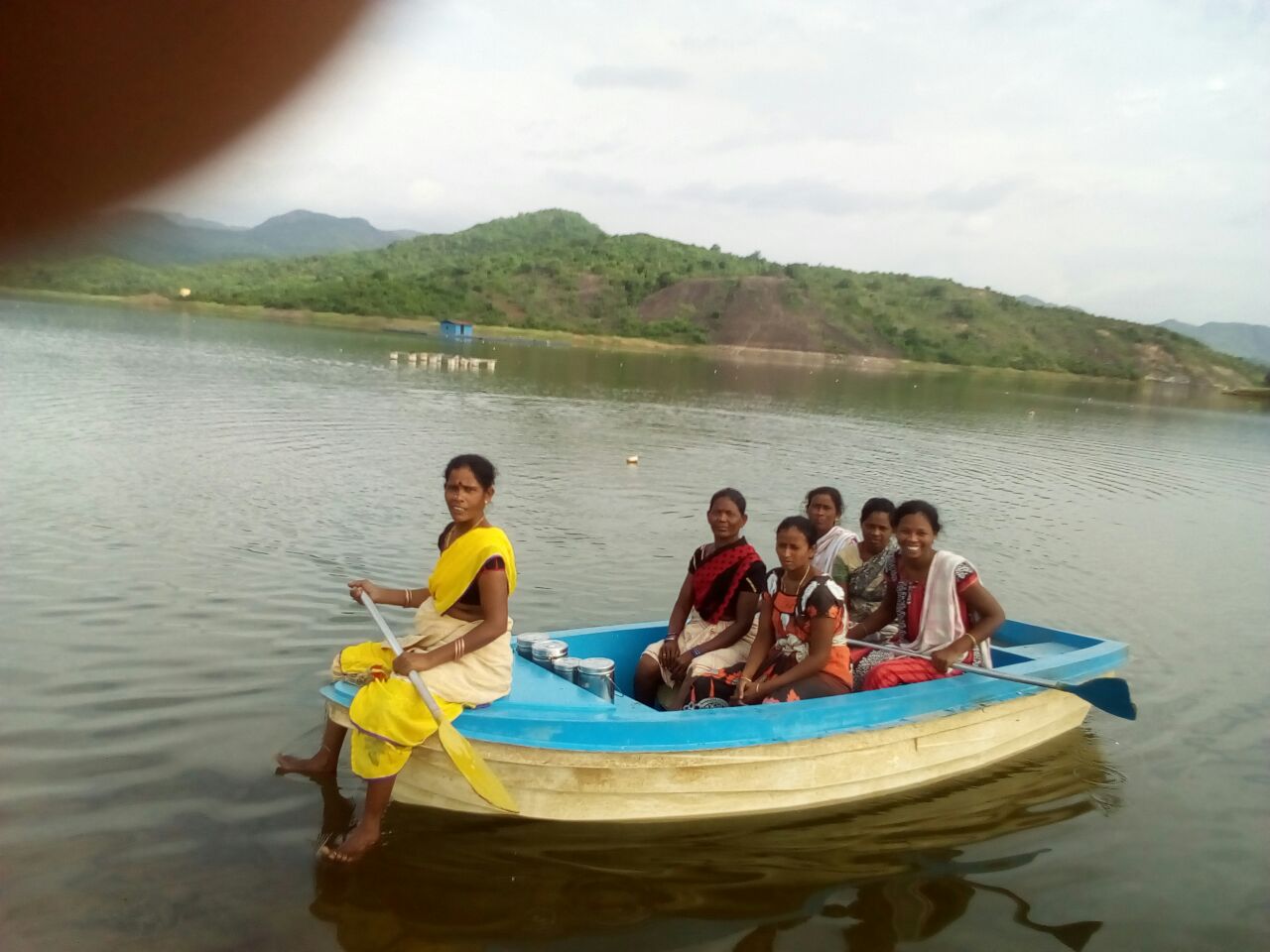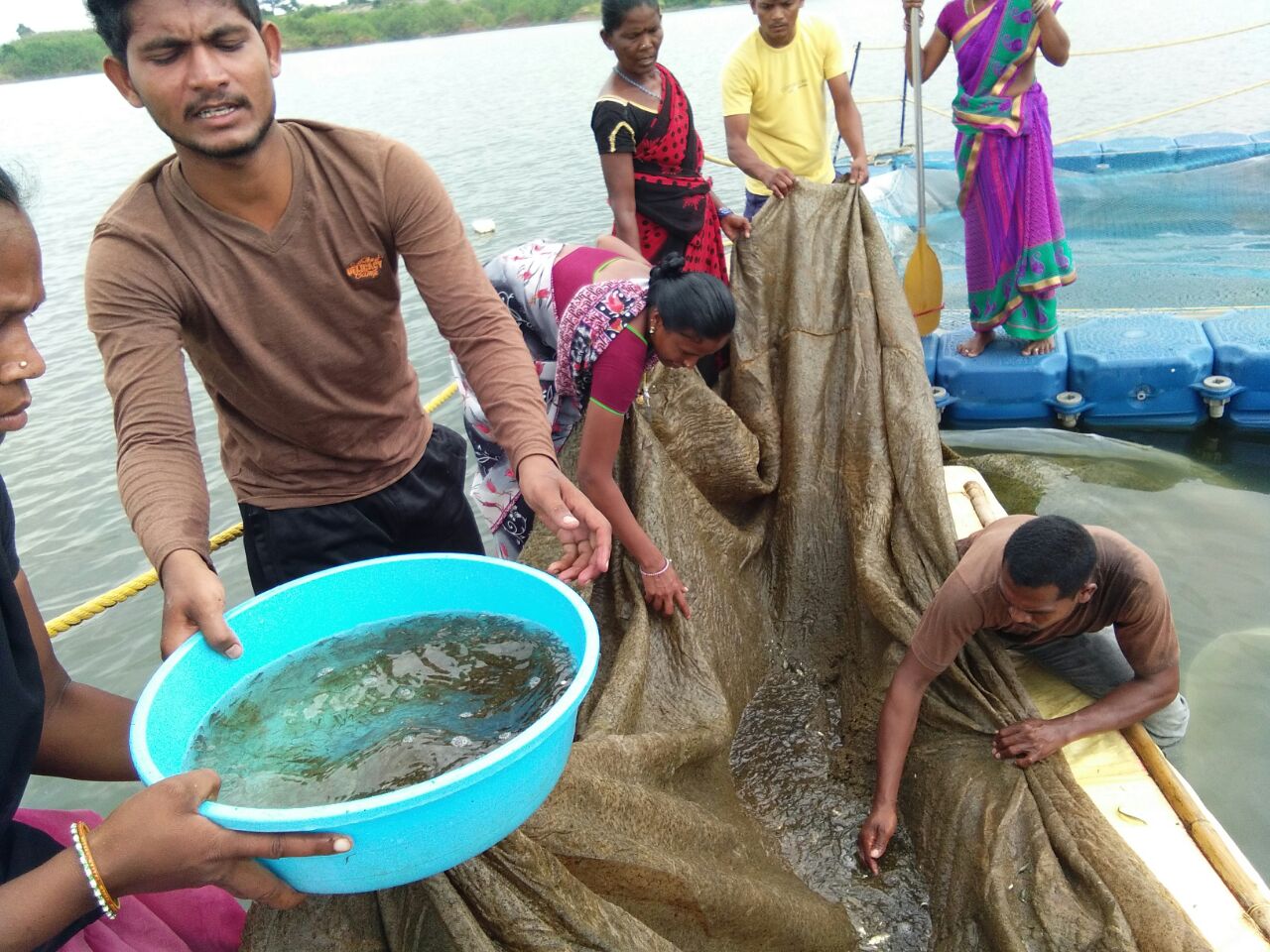
There is a reason why water bodies are considered a resource. From the water they provide to the many living organisms they support, water bodies are constantly supplying us with things essential to our survival. They also provide livelihood as this story of some enterprising tribal women in a remote village in Andhra Pradesh exemplifies. Until a few years ago, they were collecting and selling firewood from the forest for Rs 40 a day. After adopting fish rearing recently, they became so successful that they have begun to win laurels for their business exploits.
In Vizianagaram district's Pachipenta Mandal, near the state's border with Odisha, lies the nondescript Kodikallavalasa village. Bereft of any substantial development, it is close to the Peddagadda reservoir, a medium irrigation project built on a tributary of river Suvarnamukhi, which is a tributary of Nagavali.
Fish rearing was the occupation of the menfolk but they made very little out of it, just enough to eke out a living. Things changed substantially with the intervention of an NGO: Centre for Aquatic Livelihood - Jal Jeevika. In association with the Tata group's philanthropic arm Tata Trusts, they introduced them to efficient ways of fish farming. In partnership with the state fisheries department, the programme began in January 2016 when Tata Trusts' field lead Padmakar Bojja began discussions with the local fisheries cooperative society.
Income from pisciculture was so low till then that even the president of the fisheries cooperative society, Kondal Rao was contemplating migrating to Chennai to make ends meet as a labourer. However, with sustained guidance on efficient ways of fish farming, the community saw a turnaround in its fortune. So much so that on December 4 last year, six women of the local Neelammathalli Self-Help Group (SHG), led by Pakki Ratnalamma, received the award of Entrepreneur Of The Year instituted by the Central Institute of Freshwater Aquaculture, Bhubaneswar.
Harnessing the potential
Padmakar says that when he visited Kodikallavalasa village in January 2016, he observed that members of fisheries cooperative societies were not making use of the cage technique of fish rearing. In this method, fertilised fish eggs (called fish seeds) are placed in a square or rectangular enclosure and are fed until they are ready to be harvested. One of its many advantages is that unlike netting fish in an open water body, here fishes are confined to the enclosure making catching them hassle free. Using the cage method, fish can be cultivated throughout the year. This method enables fish rearing even in seasonal ponds that have water only for three to four months. 
During his conversation with members of the Neelammathalli SHG, Padmakar suggested to the women that they take up the cage method of fish rearing. Initially, they were reluctant and it took much persuasion for about 40 women to attend a meeting with the district fisheries officer in March that year. To impress upon them the economic potential of inland fisheries, they were taken on an exposure visit to Dimbhe reservoir in Pune, Maharashtra. There, they saw how rural women had begun earning Rs 6,000-8,000 per month by following the NGO’s recommendations. After the trip, 10 women from Kodikallavalasa showed interest in learning the method.
Jal Jeevika organised trainings for them and showed them how to build a cage with locally available materials such as bamboo. (E-commerce platforms sell fish cages for as much as Rs 1.2 lakh.) It educated women about constructing cages and about cage culture, its maintenance, ornamental fish rearing, managing fish feed, disease management etc.
Many hurdles to cross
With the aid of the state fisheries department, extensive capacity-building measures were taken and the women set about looking after a cage in rotational shifts. Their efforts began to yield results and they could spot maturing Rohu fish in the enclosure. However, they were unaware that when these fish grow in size, they would be capable of jumping out of the cage and to the reservoir. The women recognised the problem only after much of their fish stock disappeared. They held discussions and decided to use their old sarees to cover the cage.
Unfortunately, that was not the only time they encountered a setback. Not long ago, they had released 10 lakh fish spawn in a pond with government aid. But drought hit soon after, drying up the pond. The women had to transfer fish seeds to the cages. In fact, it was the first time that they were seeing a cage. With guidance from Jal Jeevika, they oversaw the growth of about one lakh sale-ready fish seeds but a drunk man, miffed with women's rising stature in his community, poisoned the enclosure and brought their progress to a screeching halt.
One of the women involved in fish rearing, Misala Bangaramma says that they almost gave up the venture after that episode. She says, “Once we got over the shock, we summoned our resolve to go ahead with the endeavour as that was the only way we could make a decent living and teach others how to do it for themselves.”
Learning by trial and error, the women of the SHG demonstrated perseverance, which paid off on October 9, 2017 when they sold 5,000 finger-sized young fish, weighing about 65 kg and earned Rs 10,800.
Neelkanth Mishra, the founder of Jal Jeevika and an Ashoka Fellow (fellowships are awarded to social entrepreneurs who solve social problems), says this is a remarkable journey for tribal women who had nothing to do with fisheries, yet ventured into this field, learnt the tricks of the trade and finally succeeded. He acknowledges that it took them almost a year and a half to deliver results but contends that the confidence it has instilled in the women is remarkable.
Ratnalamma of Neelammathalli SHG says, “Earlier only menfolk of our community would catch fish and sell them and the women would know nothing about how much money they were making." She compared those days with the present, where men as well as women sell fish, contribute to the household income and are aware of their finances.
Women's success in fish farming has inspired men, too. Rao says now the men's cooperative too has started working on developing a sustainable income. “They are so inspired and driven by the economic potential of pisciculture that now they want to be the best fishery cooperative in the district,” he says.
A blueprint of success
Buoyed by the success story of Kodikallavalasa village, Mishra says his NGO wants to engage 10,000 ponds across the country for inland fish rearing this year. In 2017, Tata Trusts and Jal Jeevika introduced more than 160 rural people in four districts of Andhra Pradesh (Visakhapatnam, Vizianagaram, Srikakulam and Anantapur) to efficient ways of fish farming. According to the NGO, such local enterprises fetched about Rs 1.1 crore in a year.
According to the Andhra Pradesh government, inland fisheries sector is providing livelihood to about 14.5 lakh people in the state. In 2014-15, fisheries contributed to 5.4 percent of the gross state domestic product. The southern state is number one in fish and prawn production in the country.
The state's long coastline (974 km) and productive freshwater bodies (3.4 hectares of ponds and tanks; 0.9 lakh hectare of freshwater Kolleru lake; 2.4 lakh hectares of reservoir area; and rivers and canals running 11,415-km-long) provide immense potential for fish rearing. With guidance and government support, these water bodies are capable of uplifting communities that live around them.
(The author is the executive director of a Visakhapatnam-based NGO, Vikasa, and a member of 101Reporters, a pan-India network of grassroots reporters.)